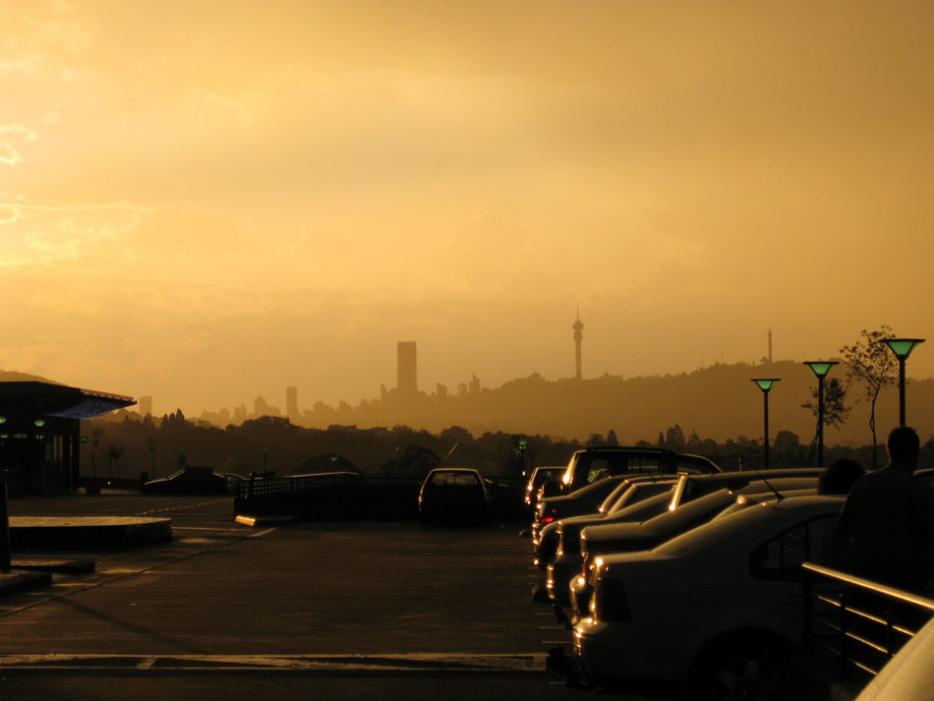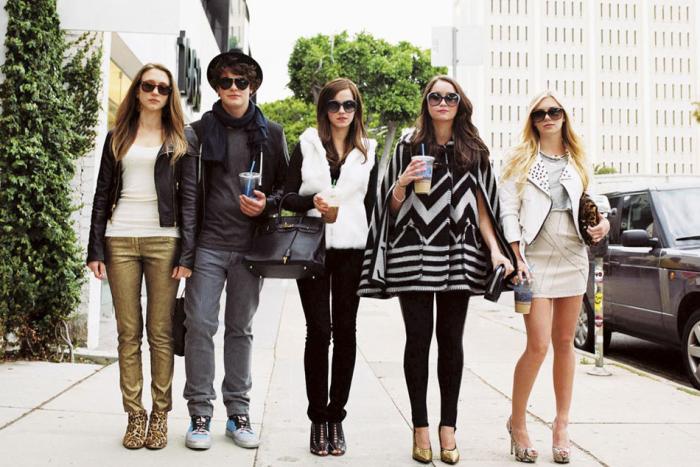I’d been warned, by people of all races, not to go to Soweto by myself. It’s dangerous. There are tour buses for that. They’ll take you to all the hot spots. There are safer ways to do it. No white person to whom I’ve spoken thinks I should take the Metro—the commuter train used by hundreds of thousands of Sowetans who commute to work every day in nearby Johannesburg. If the commuters want to wait a little less and spend a little more, they take minibus cabs—a dozen to a van for about $1, to the Metro’s 60 cents—another form of transportation I’ve been told it would be better I stay away from.
Ever since I got to South Africa, I’ve felt circumscribed by thickly drawn lines between the races. And though I know the crime rate here makes big-city USA look like Toronto by comparison, I’m getting the distinct sense that white South Africans have taken to using a perilous sort of shorthand, one I’ve seen before. It’s a form of a more general, global take on safety, and perpetuated by the tourist industry: Familiar is safe, foreign is questionable, so why take the chance? It’s natural to our essentially xenophobic selves. You can see it in the schoolyard: We don’t have to teach our kids to make fun of their fat schoolmates or to ostracize the ones who smell like unfamiliar foods for them to do so. Mandela was wrong on this point: neither we nor our kids necessarily need to learn how to hate. It’s as natural as body odor.
It makes sense to white South Africans who see the continent split between South Africa and Africa, referring to African food, African music and African vacations as if they weren’t part of it.
I’ve encountered these types of warnings in Jamaica, in St. Kitts, in Haiti and in Addis Ababa. But it’s not just black and white. In Budapest, I’ve heard tourists tell each other to be careful in the Market Hall; they haven’t personally had anything stolen, they say, but they were sure they were being followed. Going to Rome? Watch out for your wallets. Wear protective tourist gear. Suit up. It’s a jungle out there.
I have no gear. I keep my wallet where I keep it at home, in my front pocket. Sometimes I take my big camera along. And I have gone to the Budapest Market, into Basseterre, across the street from my Jamaican all-inclusive to get some actual food at a jerk stand where they’re playing cricket on the TV and debating cricket at the bar. I’ve spent five days roaming around Addis, through the Piazza and the Mercato, Africa’s largest open-air market, where my favourite Ethiopian café owner from my favourite Toronto Ethiopian café, Keeffaa, told me never to go. And I’ve gone all over Haiti, top to bottom, including a stroll and a beer in Jalousie, one of the slums that’s invariably described with words like “notorious” in news reports. On the edge of the neighbourhood, I stopped at a lean-to bar and ordered a cold Prestige. A man offered me his box to sit on. I declined, and we chatted. “You’re always welcome here,” he said. I’m not sure I remember the last time I was overtly welcomed at a bar by a fellow patron. The beer was good.
None of these experiences, of course, prove anything. Everywhere’s safe until you get stabbed. I also realize I’m male, white, and stay in hotels.11For what it’s worth, I do often travel with my boyfriend, and while we don’t tend to hold hands, at home or abroad, we do tend to sleep in rooms with one bed, take pictures of each other, have people take pictures of us with our arms around each other. We even occasionally kiss. We’ve never suffered because of it. I offer it only as an anecdotal antidote to the horror stories, many of which, in my experience, are either third-hand, or based on poorly digested statistics.
Take Jamaica. I was there two years ago, and spoke with the minister of tourism. He was very proud of the fact that in the past year, the nation’s murder rate had dropped by more than a third, down to 4,500 annually. Toronto, which has the same population as Jamaica, averages about one one-hundredth of that. The lesson for tourists seems to be, if you go to Jamaica, stay behind the all-inclusive walls—venture out and you’re dead. But when I asked about tourists, the number was quite different. One died when a stray bullet went through her car window two years earlier, I was told, but before that, nothing for a couple of years. Jamaica is not unsafe for tourists. It’s unsafe for Kingston gang members.
But better safe than sorry, you might say. It’s not the odds, it’s the stakes. That is one sort of calculus. But when it’s applied lopsidedly, it’s not only xenophobia—as I say, we’re all maleficent and beneficent xenophobes right to our genetic cores—it gets in the way of part of the very essence of travel, which, in addition to leisure and fun and routine-breaking, is about seeing other parts of the world, getting a sense of how they’re different and how they’re the same, however passively. Failing to do so is the sort of thing that lets us detach from news of a bomb in Tel Aviv or a rape in Cape Town. It reduces the potential utility of this most mobile of eras, when a billion vacations are taken each year. What’s more, this itinerant insularity marshals our money—a trillion dollars last year—in familiar directions, towards comfortable, safe multinationals, and away from the local hoteliers, bike shops, fruit stands and bars where the money would stick, instead of bouncing back to HQ.
Those were my thoughts, anyway, as they stood before I came to South Africa. After about a week here, I started thinking there might be another layer. After this past weekend, I’m pretty sure of it.
*
On Sunday, I took one of those Metro trains from Park Station in downtown Johannesburg to Orlando, one of the Soweto townships. I’d been told Park Station was a bit iffy, and no one could tell me anything about the Metro system except not to use it. The first train I got on just stayed in the station, long enough for an employee to walk by and tell me it was out of service. When the next one came, a few people climbed aboard. I followed, and asked the man across from me if this was the right train to Orlando. He said he thought it was. A half-dozen young men also got on (and off and on again, all while we sped up and slowed down—a form, I was told later, of an often-fatal game of train surfing), and the train left the station, only to stop at some sort of junction or weigh station half an hour later. It, too, was out of service. The man across from me said to follow him. We got out, onto a narrow elevated concrete gangplank obviously not meant for passengers, and made our half-kilometre way towards a bridge that led us to another station and a train that was going our way. He told me he ran errands for a Joburg Mercedes dealership and lived in Soweto. “You should have brought someone to walk with you,” he said. “It’s safer.” I asked him, as I asked every non-white person who told me it was dangerous here, whether it was dangerous for him, too. The shrug I got, every time, could have meant several things. Given the stats, I figured it probably meant, “Yes, it is, but I’m used to it.”
“This is your stop,” he told me after about 20 minutes. This was helpful; the train’s windows were almost completely opaque with dirt and abrasion. “Be safe.”
I got out of the train, feeling as unsafe as I ever had. I tried to interpret the young male stares I got. I remembered the security guard at the Johannesburg Art Gallery the day before, telling me I should take the bus the 800 metres south to Carlton Centre. “People could come and take your valuable things,” he said. I took the bus. Now here I was in Soweto, on the 37th anniversary of the Soweto Uprising, when (white) police had killed 600 schoolchildren, some of whom were protesting a new law that forced them to learn in Afrikaans. It’s called Youth Day, now, and it’s a statutory holiday with a good deal more baggage than most. And I had a lot more than 800 metres to walk. I wondered if I should take out my smartphone to check my maps. At first, I decided not to. I asked at the gas station how to get a cab to the Soweto Towers, the gorgeously painted disused nuclear plant a couple of kilometres to the south. Go to that corner, hold out four fingers, someone will stop. I did as instructed. No one stopped.
Eventually, I took out my phone to see how far I was from Nelson Mandela’s house and the museum devoted to the memory of Hector Pieterson, the 12-year-old who died on that other June 16, and whose death is generally considered to have been the first nail in Apartheid’s already overdue coffin. Not far. I walked another kilometre or so until I saw the crowds. There were a few white faces, but these were mostly black South Africans, celebrating Youth Day where it began, many in their Porsche SUVs and Mercedes coupes, filling the bars and restaurants, and packing Mandela’s tiny old house, police bullet holes still in evidence in its brick and concrete façade.
I walked the June 16th trail, where the crowds disappeared and it was just locals going about their day. I felt safer now, mostly because of the crowds just a few hundred metres away, but I had no reason to. There were always crowds in Soweto. There were crowds 37 years ago, and there’d be crowds tomorrow. The population here is bigger than Johannesburg proper as it was defined before a metropolitan merger in 2000, and much more densely distributed. It’s no protection in a part of the world so inured to crime that gang rapes don’t even make the news.
Here’s that other layer I was talking about.
We encourage our kids to take part in 24-hour hunger drives to raise money and get a taste of what it’s like to be without food, as so much of the world is. Every once in a while, an activist or a journalist will sleep on the streets, sometimes for a night, sometimes longer, to experience and call attention to another fact of life for millions. It’s always struck me as play-acting, condescending even, no matter how well-intentioned. But the motivation, I think, is a good one. A billion or so of us live in quite remarkable circumstances. They seem normal to us—a baseline, even, from which to demand even more rights and securities. But to most of the rest of the world, it’s barely fathomable.
I was speaking just this morning to Brigitte, a white native twenty-something Joburger, one of the ones who’s never used the Metro. We were talking about my trip to Soweto. She mentioned the cars she’d had stolen. She talked about her flat, where, once you get past the security guard, there are three locks to open to get inside, and even then, she locks every interior door between rooms behind her as she passes from one to the next. A friend’s parents had been woken several years ago in their beds by men who put guns in their mouths, she said, and the friend of another friend had been gang-raped. She’d been mugged. I asked her if she ever considered moving. Sure, she said, but her family’s here, her friends are here. And anyway, she said, only half in jest (I think), she wouldn’t know what to do if she weren’t always feeling somewhat threatened.
Take that feeling, multiply it for black South Africans—who are attacked, raped and killed at a much higher rate than whites—and then spread it out across the rest of Africa, Western Asia, Southeast Asia, India, Central America, and the Middle East, and what you’ve got is a basic fact of life.
So perhaps it goes beyond getting over our reflexive fear of strange people and places. Perhaps that very sense of insecurity, of danger, is one of the things about travel that should be embraced, along with the conch salad, the Zulu drumming, the raki and the ruins. This is how it feels to be alive almost everywhere.






